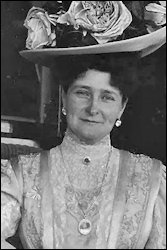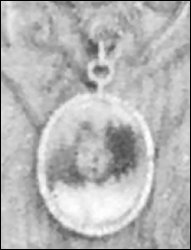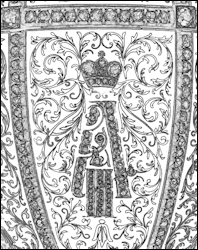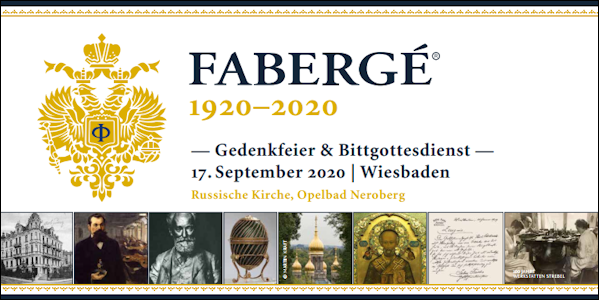
September 17, 2020 – Russian Orthodox Church of Saint Elizabeth on the Neroberg in Wiesbaden (Germany)
Program Notes (in German)
RSVP to Horst Becker, participation is limited to 80-100 guests
On September 24, 2020, the actual the 100th anniversary date of Fabergé’s death. “Fabergé-Panel Pully” will be presented to the Foundation La Rambarde, Pully La Rosiaz, Switzerland (former Hotel Bellevue where the Russian jeweler Fabergé spent his last days).
Dr. Marina Lopato, dedicated Fabergé curator and scholar at the Hermitage Museum in St. Petersburg, Russia, died on July 27, 2020.

CLICK THE ABOVE PICTURE FOR A LARGER VIEW
Fabergé Venue at the General Staff Building
(Photograph Viktoria Petrova, Hermitage Museum)
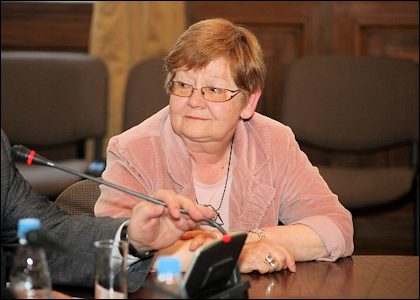
Hermitage Museum Fabergé Specialist Marina Lopato (1942-2020),
St. Petersburg, Russia
(Photograph Galina Korneva)
- August Holmström (workmaster mark AH
 , active 1857-1903), and
, active 1857-1903), and - August Hollming (workmaster mark A*H
 , active 1880-1913).
, active 1880-1913).
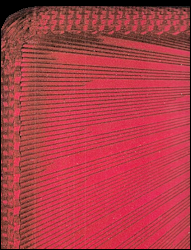
A.
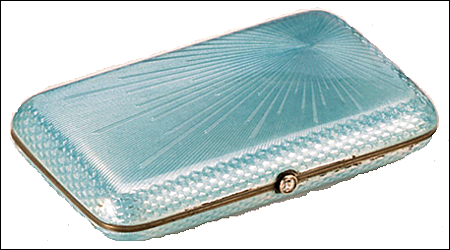
B.
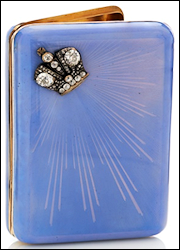
C.
(B.) Enamel and Silver-gilt Lady’s Cigarette Case, Workmaster August Hollming, St. Petersburg, Russia, 1899-1908, Size: 8 cm (Sotheby’s Geneva, November 17, 1998, Lot 409; Sotheby’s London, December 1, 2005, Lot 345)
(C.) Enamel Gold Cigarette Case, Diamond-set Crown, August Holmström, St. Petersburg, 1896-1908, Size: 9.6 cm (Danish Royal Collection; Koldinghus (Denmark) Museum Exhibition Catalog, Faberge – Tsar’s Court Jeweler and His Association to the Danish Royal Family, 2016, pp. 40, 85)
Provenance: Presented to Crown Prince Frederik, who represented King Christian IX at the Tsar’s [Nicholas II] Coronation in Moscow on May 26, 1896.
For Imperial presentation cigarette cases decorations in gold, silver, or platinum were added to the cases’ covers. The earliest example found so far with a diamond-set crown at the center of the sunburst is an Imperial presentation case from the August Holmström (C.) studio. Presented to Crown Prince Frederik VIII at the coronation of Nicholas II in 1896, it is solid gold, because of the recipient’s importance. Fabergé’s production line must have been in high gear the year before the Russian coronation to keep up with all the gifts the Imperial Cabinet authorized and presented, or Nicholas II personally presented to dignitaries on this auspicious occasion. Other Russian Imperial presentation gifts are distinguished with an insignia, i.e., the double-headed Eagle, the Imperial Crown, the Emperor’s diamond cypher, or a miniature portrait.

D.
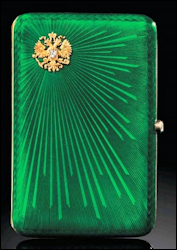
E.
Provenance: Stock number 1189.
(E.) Enamel and Silver-gilt Cigarette Case, Gold Imperial Eagle Centered with a Diamond, August Holmström, St. Petersburg, 1899-1904 (Christie’s, London, November 25, 2013, Lot 238)
Provenance: Presented to Captain John Nicholas, M.V.O., R.H.A., appointed to Superintendent at the Royal Mews, Buckingham Palace in 1901.
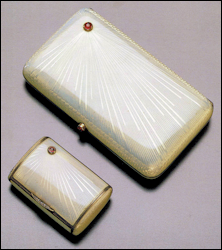
F.
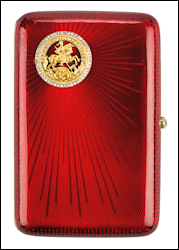


G.
Provenance: Unknown, Case and Box Inventory Numbers – Case /R/2/529, Match Box 529/2 are not typical Fabergé stock numbers.
(G.) Enamel and Silver-gilt, Cigarette Case, Medallion Showing St. George Slaying the Dragon within a Diamond-set Bezel, Sunburst Guilloché Pattern on the Back of the Case, and August Holmström Mark, ca. 1900 (Sotheby’s, New York, October 23, 2003, Lot 64; the Ruzhnikov website has stunning close-ups of the objects suggesting the workmaster was Albert Holmström [son of workmaster August Holmström, who took over the workshop in 1903 after his father’s death, applied for and was granted the same workmaster mark], 1903-1908).
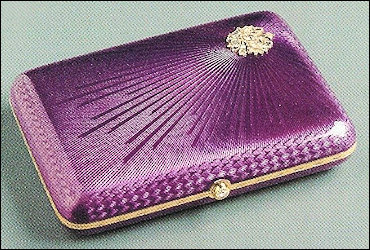
H.
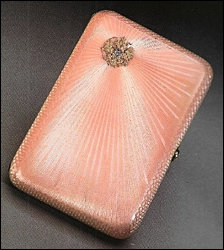
I.
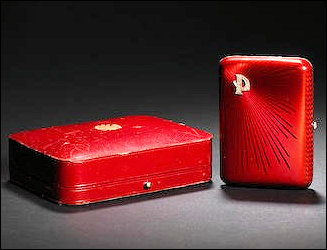
J.
Provenance: Unknown.
(I.) Enamel and Silver-gilt Cigarette Case, Gold Imperial Eagle Centered with a Diamond, August Hollming, 1896-1908, Original Fitted Case (Traina, John, 1998, p. 62)
Provenance: Presented by the Imperial Cabinet on behalf of Emperor Nicholas II to Eduard Vella in May 1902 for services rendered at the Russian consulate in Malta. Stock number 4984.
(J.) Enamel and Silver-gilt Cigarette Case, Initial “P” with Single-cut Diamonds, August Hollming, 1899-1908, Original Fitted Leather Case with a Gold Imperial Eagle Imprint (Bonhams, London, May 30, 2012, Lot 205 sold with supporting documentation. The two documents [left in Russian and right in German] are somewhat illegible in the hard copy auction catalog, and are not shown on the Internet. The Russian one appears to relate to the Order of St. Anne (?), dated either June or July 24, 1908. Is it possibly a formal thank you to Nicholas II for awarding the order, while the German text is dated a year later [June 1, 1909] suggesting an Austrian order of the Iron Cross, 3rd class, was presented to the recipient? More research is needed.)
Provenance: Presented by Nicholas II to Don Jose Pulido after awarding him the Cross of St. Anne. The Spanish Aide to the Infant Don Fernando of Spain visited Russia in June 1908.
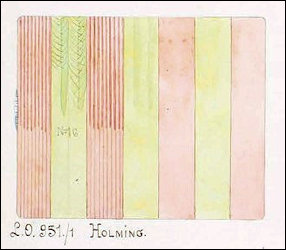
K.

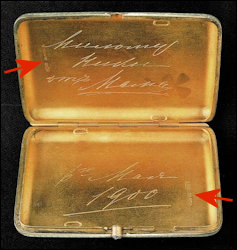
L.

M.
Provenance: “For Dearest Nicky, from Mom. 6 May 1900”, Gift from His Mother, Dowager Empress Maria Feodorovna, for Emperor Nicholas II’s 32nd Birthday
(M.) Pink Enamel and Silver-gilt Cigarette Case, Diamond Clover Leaf, ca. 1900 (From a Snowflake to an Iceberg: The McFerrin Collection, 2013, p. 58; Sotheby’s New York, April 17, 2012, Lot 330)
Provenance: Mrs. Walter Matthau, wife of actor Walter Matthau.

Birthday Gift from the Dowager Empress Maria Feodorovna to
Emperor Nicholas II
(Photograph Christel McCanless)
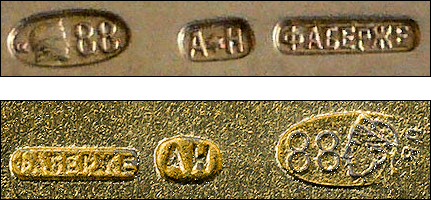
Which One of These Is It? Standard Mark on August Hollming Cigarette Case, Not
a Sunburst Pattern Case (Russian-Antique.com) by August Holmström Mark
(C. above in this essay)
Traina text suggests the gray-green color (later called sage-green) of the case was the color of the Preobrajensky Regiment, to which he [Nicholas II] belonged, had been founded by Peter the Great, and was the most prestigious. (Wikipedia states the regiment’s color was “predominantly of a dark green, eventually verging on black.”)
On the Russian Fabergé Museum website, the gift is incorrectly tied to the Name Day (December 6th) of Nicholas II.
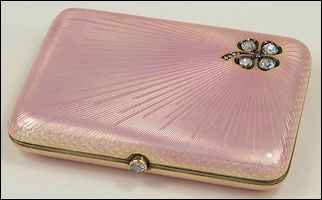
Pink Enamel and Silver-gilt Cigarette Case,
Diamond Clover Leaf, ca. 1900
(McFerrin Foundation Collection, From a Snowflake
to an Iceberg, 2013, p. 58; Sotheby’s New
York, April 17, 2012, Lot 330)
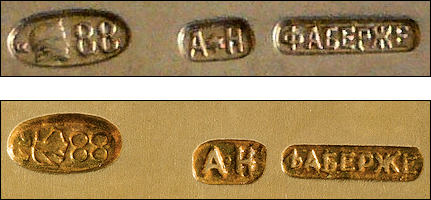
Typical Hollming Mark (Russian-Antique.com)
Hollming Hallmark with a Dot and
Not the Usual Star on the McFerrin Cigarette Case
(Sotheby’s New York, April 17, 2012, Lot 330)
McFerrin text: “Albert Holmström or August Hollming” (From a Snowflake to an Iceberg: The McFerrin Collection, 2013, p. 58).
Albert Holmström applied for his late father’s mark in 1903, and used it until 1917 when the Fabergé firm closed.
Other objects (Atzbach | Ruzhnikov | Bonhams) with the ![]() Hodges, 2009, pp. 60-61
Hodges, 2009, pp. 60-61
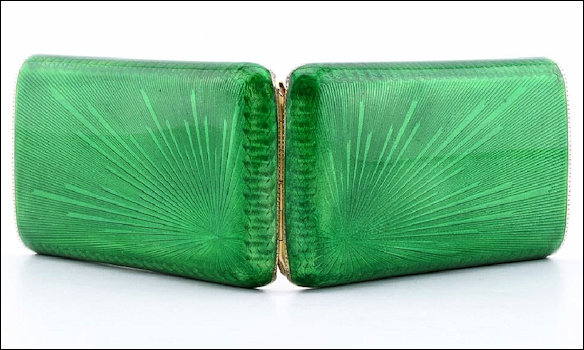

O.
Auction house in 2019: A FABERGÉ SILVER-GILT AND GUILLOCHÉ ENAMEL CIGARETTE CASE, WORKMASTER AUGUST HOLLMING, ST PETERSBURG, 1899-1903, rounded rectangular form, enameled in translucent vivid green over a sunburst engine-turned ground, the interior engraved K.F. oz (sic, oz is an abbreviation for ounces in English, more likely a date ending with 03), struck inside with the workmaster’s initials, Fabergé in Cyrillic, 88 standard, scratched inventory number 9917; with leather case. Length 3 in. (7.7cm)
1 Tillander-Goldenhielm, Ulla. Golden Years of Fabergé, Drawings and Objects from the Wigström Workshop, 2000, pp. 33-34, discusses the production methods.
2 Tillander-Godenhielm, Ulla. Fabergé: His Master Artisans, 2018, p. 97.
3 A brief visual introduction to guilloché. Fabergé Research Newsletter, Fall and Winter 2018
4 Adams, Timothy. “Fabergé Design Sketches and What They Teach Us”, Fabergé Research Newsletter, Fall and Winter 2018.
5 Fabergé Research Newsletter, Fall 2014
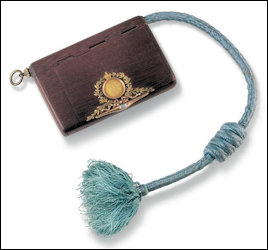
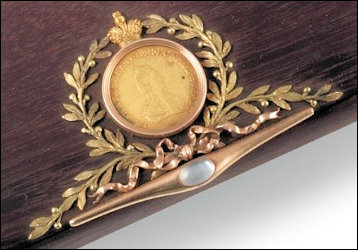
A.
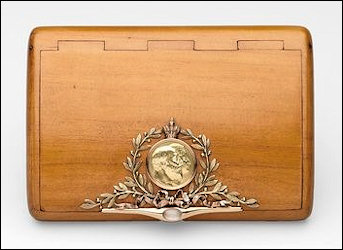
B.
Provenance: Gloria, Property from the late Dowager Countess Bathurst (1927-2018), Stock Number 8673.
(B.) Cigarette Case, Birch Wood, Marked Fabergé, 1896-1908 (Royal Collection Trust)
Provenance: Presumably acquired by King Edward VII; given to King George V by Queen Alexandra.
The British Royal Collection case (3.5 x 2.2 in.) was “presumably acquired by King Edward VII; given to King George V by Queen Alexandra”2, and probably sold from the London Fabergé shop managed by Allan Bowe3 in 1903 or 1904. The shop opened in September 1903 and Bowe operated it until June/July of 1906. Géza von Habsburg first published information on the London Sales Ledgers4 documenting items sold from 1907-1917, unfortunately no sales records have survived for the years 1903-1906.
The Bathurst cigarette case at auction made from palisander wood with a blue tinder cord has one other difference. Instead of a medallion of Edward VII and Alexandra this case has an 18th century gold coin depicting the Russian Empress Catherine the Great (1729-1796, reigned from 1762-1796). Upon a closer inspection the crowns on the two cases resemble the Russian Imperial crown, while the Royal Collection piece does not have a British crown of St. Edward. My suspicion is the royal case originally held an 18th century Russian ruble. Perhaps it was replaced with the British royal medallion at the request of the purchaser (presumably King Edward VII) when it was purchased ca. 1903-1904. The scratched stock number 8673 on the palisander case suggests a Fabergé production date of 1903.
Viktor Aarne Cigarette Cases
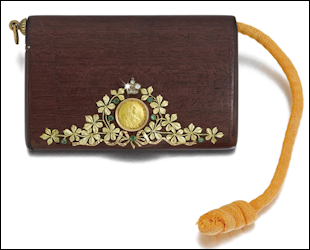
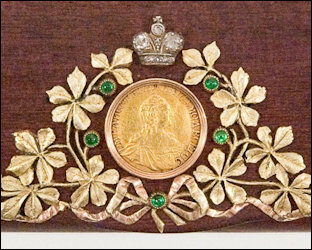
C.
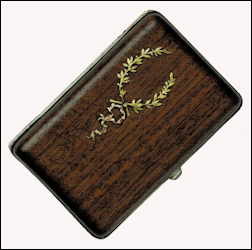
D.
Provenance: Grand Duchess Maria Pavlovna of Russia (1854-1920), now on view in the McFerrin Gallery, Houston Museum of Natural Science in Texas.
(D) Cigarette Case, Palisander Wood, Viktor Aarne, Marked on Inner Rim and Wreath, 1896-1908 (Christie’s London, June 9, 2009, Lot 199)
Provenance: Stock Number 8674
The McFerrin cigarette case (C.):
- Has a tinder cord and is topped by a gold diamond-set crown with a gold Russian ruble depicting Empress Elizabeth Petrovna (1709-1762, reigned 1741-1762), and not Empress Catherine the Great (1729-1796, reigned from 1762-1796).
- Lacks the gold and moonstone thumbpiece, and a stock number.
- The extra elegance and luxury exuding from the gold leaves and the emeralds reflect the taste of its Imperial owners whose court rivaled the extravagance of Emperor Nicholas II’s court.
- The workmaster is Viktor Aarne (J.V.A and BA
 , active 1890-1904).
, active 1890-1904).
It is likely the two unmarked wooden cigarette cases (A. and B.) similar in design and workmanship, and made in 1900-1904, may also come from the Aarne workshop, or Aarne’s successor workshop, Hjalmar Armfelt (ЯА ![]() , active 1904-1917).
, active 1904-1917).
Hjalmar Armfelt Cigarette Case
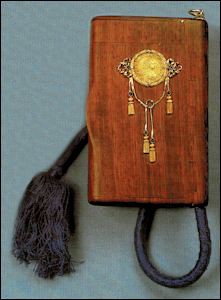
E.
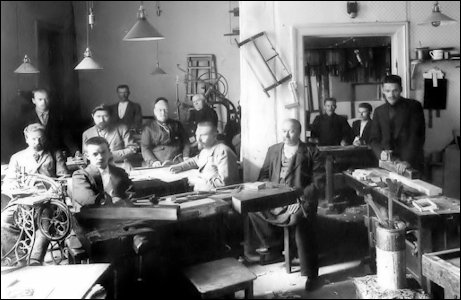
F.
Provenance: Hodges Family Collection, Stock Number 15920
(F) Simo and Matilda Käki Case Master Studio, Court Yard Building at the House of Fabergé Premises in St. Petersburg, Russia. Matilda is Seated Left of Center in the Middle Ground (Courtesy Fersman Mineralogical Museum, Moscow, and Ulla Tillander-Godenhielm)
- Constructed of palisander wood adorned with a gold Russian ruble depicting Empress Elizabeth Petrovna (1709-1762, reigned 1741-1762).
- A tinder cord is present, instead of laurel or chestnut leaves the coin is surrounded by gold bows and dripping gold tassels studded with cabochon sapphires.
- No gold thumb piece, but what really strikes the eye is the applied coin decoration oriented vertically rather than horizontally.
- The gold marks are for 1904-1908, which coincides with the date when Armfelt took over the Aarne’s workshop sometime in 1904.
A pleasant surprise during this research was to learn the Armfelt cigarette case has a storage/presentation case. Kieran McCarthy7 in his 2009 article states these details –
1 Also known as rosewood due to its strong sweet smell lasting for many years.
2 de Guitaut, Caroline. Fabergé in the Royal Collection, 2003, p. 141.
3 Bonus, Wendy. The Fabergé Connection: A Memoir of the Bowe Family, 2010.
4 von Habsburg, Géza and Marina Lopato, Fabergé: Imperial Jeweler, 1993, pp. 124, 131 (footnotes 1-2).
5 Fabergé Smoking Accessories: Materials and Techniques of an Art Form by Christel McCanless and Timothy Adams presented at the 2016 Fabergé Symposium in Houston, Texas (Fabergé Research Newsletter, “Fabergé Smoking Accessories: Materials and Techniques of an Art Form” PowerPoint Presentation and Handout).
6 Sotheby’s London, November 30, 2009, Romanov Heirlooms: The Lost Inheritance of Grand Duchess Maria Pavlovna, featured in Fabergé: The McFerrin Collection. The Opulence Continues…, 2016, pp. 128-131.
7 Kieran McCarthy discusses “Faberge’s Work in Wood” in Keefe, John. Fabergé: The Hodges Family Collection, 2009, pp. 30-31.
8 McCarthy, Kieran. Fabergé in London: The British Branch of the Imperial Russian Goldsmith, 2017, p. 20.

Fabergé Aquamarine Jeweled
Brooch by August Hollming,
1899-1908
(McFerrin, Dorothy, From a
Snowflake to an Iceberg: The
McFerrin Collection,
2013, p. 182)

Translated text: Brooch, marked A.H.
for August Fredrick Hollming or
August Wilhelm Holström (sic),
within the Fabergé Workmaster
Circles in St. Petersburg. Gold and
Silver. Skr 8,700.
(Auktionsverk, Stockholm, April 26, 1977)
Sotheby’s London, Russian Works of Art, June 9-17, 2020
Auction review by Andre Ruzhnikov: Sotheby’s Russian Sales June 2020 published July 10, 2020.
Sotheby’s website has a new feature highlighting Fabergé objects with these topics:
- Works by Carl Fabergé at Sotheby’s
- Carl Fabergé Biography
- Carl Fabergé Videos and Stories
- Museums with Works by Carl Fabergé
Christie’s London, Russian Art, July 1-21, 2020, with a separate listing of sale results.
Auction reviews by Andre Ruzhnikov:
Christie’s Russian Sale July 2020: Bric-a-Brac, Not Antiques! published July 15, 2020
Plates & Rückert Emerge from Christie’s Bric-A-Brac, published July 27, 2020
Christie’s London, Gloria: Property from the late Dowager Countess Bathurst, July 22, 2020 online auction, hard copy catalog was published.
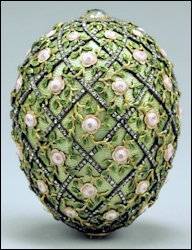
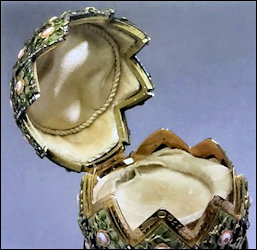
1907 Rose Trellis Egg and Interior with an Impression for the Locket Surprise
(Courtesy Annemiek Wintraecken)
Surely, I am not alone in being frustrated by images of historic photographs which cannot be brought up to the level of clarity we would hope to use in our research. In this case, the reveal of this 1907 ‘surprise’ centers on a photograph of Alexandra Feodorovna sitting in a cushioned wicker chair on the deck of the Imperial yacht Standart. At first glance, my eye perceived the locket’s image as Alexandra’s niece, Princess Elisabeth of Hesse and by Rhine.
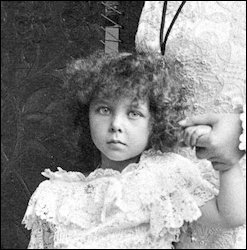
Princess Elisabeth of Hesse and by Rhine, 1898
(Royal Collection Trust) Additional pictures
can be found in a Youtube video at
1:00 and 1:20 minutes.
An alternative scenario for the locket, were it in fact the Empress’ niece, might be extrapolated from family history. Alexandra and her brother, Grand Duke Ernst Ludwig of Hesse (Ernie), were terribly close siblings, and even closer when his only child (at that time), Elisabeth – ‘Ella’ – died suddenly of a virulent form of typhoid on 16 November 1903, whilst on holiday with Nicholas, Alexandra, and their four daughters at the Imperial Hunting Lodge Skierniewice in Russian Poland.
In narratives related to the 1907 Rose Trellis Egg, there is always commentary concerning Alexandra’s love for flowers. However, the motif of this egg invariably piqued my memory. In 2007, I was returning to Schloss Wolfsgarten, the former hunting seat of the ruling family of Darmstadt with its surrounding Hessian properties, and while there visited the garden park Rosenhöhe, and the grave of ‘Ella’ within its precincts.


The Dome of Rose Trellis Egg Resembles the Dome of Rosenhöhe in the Garden Park, Darmstadt (Germany)
(Photos Courtesy Annemiek Wintraecken and Wikimedia Ludwig Bickel / CC BY-SA respectively)
1 Fabergé, Tatiana, et al, The Fabergé Imperial Easter Eggs, 1997, p. 176.
2 Kleinpenning, Petra H., Ed. The Correspondence of the Empress Alexandra of Russia with Ernst Ludwig and Eleonore, Grand Duke and Duchess of Hesse: 1878-1916, 2010, p. 275.
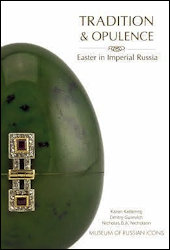
Catalog to Accompany the Museum
of Russian Icons, Clinton (MA)
Tradition & Opulence: Easter in
Imperial Russia Exhibition
- Houston, Texas. Houston Museum of Natural Science
Jennifer McFerrin Bohner writes: Lots is going on at the McFerrin Collection! A new exhibit, The Art of Everyday Objects in the McFerrin Gallery, is planned for April 2021-2023, and will include most major items and important pieces of provenance along with everyday objects – desk accessories, bell pushes, glasses, women’s accessories, etc. The adjoining vault area accessible to the public will feature the rest of the collection. We are always looking for new information-connections-insights about our pieces and then sharing the information with our visitors through docent training, exhibition publications, and online articles. We welcome all Fabergé enthusiasts interested in research regarding objects in the McFerrin Collection, please email us any time. We would love to work with you!
2020 Loans:
-
Venue at the Hillwood Museum, Washington (DC), Natural Beauties: Exquisite Works of Minerals and Gems, February 15, 2020 – January 3, 2021 (new closing date) includes four hard stone objects from the McFerrin Collection.
-
Exhibition of the Museum of Russian Icons, Clinton (MA), Tradition & Opulence: Easter in Imperial Russia, April to October 25, 2020, showcases 33 pieces from the McFerrin Collection.
- Catalina Island Museum (CA), Fabergé at Sea, May 21, 2021 – Oct 21, 2021. The McFerrin Collection will loan 13 Fabergé objects connected to Imperial yachts and military cruisers. The venue moves to the Houston Museum of Natural Science, November 2021 – July 2022.
-
Venue at the Hillwood Museum, Washington (DC), Natural Beauties: Exquisite Works of Minerals and Gems, February 15, 2020 – January 3, 2021 (new closing date) includes four hard stone objects from the McFerrin Collection.
- St. Petersburg, Russia. Fabergé Museum
Visit their YouTube Channel, and also enjoy a potpourri of objects from the museum’s permanent collection.
- Washington, DC. Hillwood, Estate, Museum & Gardens
Learn about Hillwood’s current, future and past exhibitions. The current venue, Natural Beauties: Exquisite Works of Minerals and Gems, February 15, 2020 – January 3, 2021.
Explore Hillwood to stay up-to-date with new videos, activities, information, and more, especially as the gardens bloom and burst with color. Weekly updates mailed to subscribers.
- April 7 – extended to October 25, 2020 Museum of Russian Icons, Clinton (MA)
Tradition & Opulence: Easter in Imperial Russia, an exhibition of nearly 200 objects, will recreate the splendor of Easter celebrations during the last days of the Tsars. A catalog with the same title has been published, and is illustrated above.
Online lectures: Kettering, Karen, “Decoding the Iconography and Symbols of Easter in Russian Art”
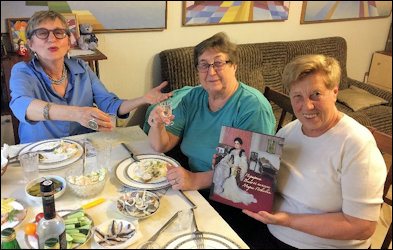
Spring 2020 Galina Gabriel Honoring “The Sisters” and Their New Book
in St. Petersburg, Russia
(Photograph Courtesy Galina Korneva)
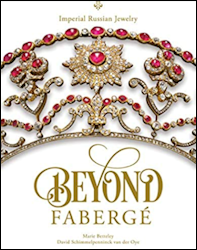
Monograph about Russian Jewelers
and Silversmiths to Be Unveiled in
October 2020
(Courtesy Schiffer Publishing)
But the 20th century changed the smooth development of history. The names of Grand Duke and Grand Duchess Vladimir were mentioned only in the scientific literature during the next hundred years. It was forbidden to tell about their contributions even in the Scholar’s Club of the Russian Academy of Science, which is located in a former palace of Grand Duke and Grand Duchess Maria in St. Petersburg, at the Dvortsovaya (Palace) embankment, 26. Historians usually discuss only that the Grand Duke gave an order to fire at the peaceful demonstration of workers on 9 (22) January 1905, and that his widow Maria Pavlovna headed a family plot against Emperor Nicholas II.
The only theme discussed widely in recent years is the description of a unique jewelry collection belonging to Grand Duchess Maria Pavlovna. Interest in this collection grew after the auction (Sotheby’s London, November 30, 2009, Romanov Heirlooms: The Lost Inheritance of Grand Duchess Maria Pavlovna), in which Fabergé cigarette cases and cufflinks lost for 90 years were sold. An analysis of the paintings collected by the grand ducal family2 demonstrates the value of the paintings is as great as the jewelry. Impeccable taste, a refined eye, and the knowledge of art attributed to the owners were helpful in creating the collection. Moreover, Grand Duke Vladimir and Grand Duchess Maria alternately headed the Imperial Academy of Arts in St. Petersburg for almost half a century. This position gave them opportunity to know well the main directions and events in the world of art both in Russia and Europe. There can be no doubt that the grand-ducal family selected even more carefully the artists chosen to paint their own portraits and portraits of their children. Among them were well known Russian and foreign Masters: Konstantin Egorovich Makovsky (1839-1915), Boris Mikhailovich Kustodiyev (1878-1927), Lev Samuilovich Bakst (1866-1924), Stepan Fyedorovich Aleksandrovsky (1842-1906), Aleksander Mikhailovich Leontovsky (1865-1928), Ernst Karlovich von Lipgart (1847-1932), Baron Heinrich von Angeli (1840-1925), Francois Flameng (1856-1923), Albert Edelfelt (1854-1905), and Sophia Vladimirovna Khotyaintseva (1837-1891). Even in a circle of these famous artists, the name of French painter George Bekker (1845-1909) stands out. He painted a portrait of Grand Duchess Maria Pavlovna set in her Cabinet in their St. Petersburg Palace. The portrait has some unquestionable merits from historic, artistic, and other points of view. It is notable also for its financial value.
1 Korneva G., Cheboksarova T. “Velikaya Knyaginya Maria Pavlovna”. SPb. 2014; G. Korneva, T. Cheboksarova “Grand Duchess Maria Pavlovna”. SPb. 2014. Other books in English by the authors include St. Petersburg. By the World Created — by Its Beauty Preserved (2003), Empress Maria Feodorovna’s Favorite Residences in Russia and Denmark (2006), and Russia and Europe. Dynastic Ties (2012).
2 Articles written by G. Korneva and T. Cheboksarova in Khudozhestvenny Vestnik (Art News) appeared in 2016-2018.
Learning tools:
- Lesley Andrews, a member of the Cape Town Gem & Mineral Club, published an article, “Faberge’s Birds” in the club’s newsletter, Mineral Chatter, August 2020. Thank you for sharing it.
- Thomas Holman of Wartski London is teaching readers the basics in a “Brief Introduction to Enamel”.
- The in’s and out’s of the Engine Turning/Guilloché process which incises metal with a pattern used in Faberge’s time and still today is explained by David Wood-Heath, a British engine turning machine collector who restores and uses his treasured antique models. He presented the talk at the 2016 Ornamental Turners International Symposium in Denver, Colorado. The Fabergé Research Newsletter has briefly covered this topic complete with illustrations twice (Fabergé Research Newsletter Spring 2012 and Spring and Summer 2017 editions).
- Nicholson, Nick, “Black Gold: Russian Lacquer from the 18-20th Centuries” includes five lacquer boxes with Fabergé decorations. (Courtesy Russian History Museum)
- Kettering, Karen, “A Mass of Brilliant Color: Vestments for the Coronation of Nicholas II and Alexandra Fedorovna” (Courtesy Russian History Museum)
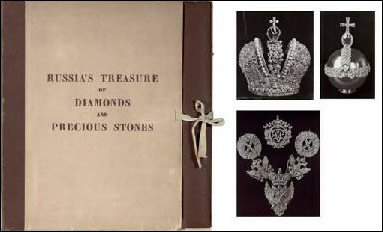
Fersman Portfolio
(Courtesy Christie’s)
Are you aware with a few clicks of your mouse on the Royal Collection Trust website you can find a biographical details about Fabergé workmaster Mikhail Perkhin (born 1860-1903, active 1886-1903) and see a collage of 101 objects complete with illustrations and descriptions made by his studio, now in the collection of Queen Elizabeth II. Try it also for other Fabergé workmasters!
The dealer website of Andre Ruzhnikov is a nirvana for Fabergé researchers. At the bottom of most of his Fabergé objects there is a link to “related works” with stunning pictures, and object details – a journey worth taking! What is your favorite type of object?
- Desk Clocks
- Frames
- Parasol Handles
- Cigarette Cases
- Bell Pushes
- Compacts
- Romanov Imperial Antiques
- Just published, The Clock Collection complete with 77 illustrations.
Faberge objects from the dealer’s website, Romanov Russia, are attractively photographed and described with myriad details.



